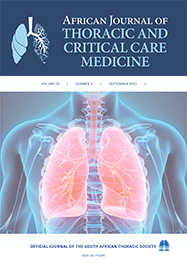Original research

Invasive fungal infections in a paediatric intensive care unit in a low-to middle-income country
Abstract
Background. Paediatric intensive care units (PICUs) are high-risk settings for healthcare-associated infections. Invasive fungal infection (IFI) is one of the common causes of healthcare-associated infections.
Objective. To describe the prevalence and short-term outcomes of children with IFI, and to offer a basis for the efficient prevention and treatment of IFI.
Methods. A retrospective study was conducted in children under the age of 12 years over a two-year period. Participants were categorised according to pre-defined microbiology criteria into IFI if they had a positive culture from blood or other sterile sites. Data collected included demographics, invasive procedures, length of stay and mortality.
Results. One thousand and forty-two children were admitted during the study period. Of the total, 56.8% (n=592) were male. Median length of stay was 18 days (mean±SE 18.6±8.9). IFI was identified in 35 cases per 1 000 admissions, with 77.7% of these infants under the age of one year. The mean length of stay was 18.6 days compared with 7.5 days for children with bacterial infections. The in-hospital mortality for invasive fungal infection was 36% compared with 16% for all admissions. Findings confirmed that colonisation was more prevalent than IFI.
Conclusion. IFIs are common among infants, and these patients have a higher mortality rate and prolonged hospital stay. Therefore we recommend early diagnosis and timely treatment with high-performance antifungal drugs to improve the prognosis in children with IFI. Keywords. Healthcare-associated infections, South Africa, neonates, mortality, sepsis
Authors' affiliations
S T Hlophe, Department of Paediatrics and Child Health, Nelson R Mandela School of Clinical Medicine. University of KwaZulu-Natal, Durban, South Africa
P M Jeena, Department of Paediatrics and Child Health, Nelson R Mandela School of Clinical Medicine. University of KwaZulu-Natal, Durban, South Africa
Y Mahabeer, Department of Medical Microbiology, National Health Laboratory Service, Durban, South Africa, and School of Laboratory Medicine and Medical Sciences, College of Health Sciences, University of KwaZulu-Natal, Durban, South Africa
O R Ajayi, Department of Paediatrics and Child Health, Nelson R Mandela School of Clinical Medicine. University of KwaZulu-Natal, Durban, South Africa
N P Govender, National Institute for Communicable Diseases (Centre for Healthcare-associated Infections, Antimicrobial Resistance and Mycoses), National Health Laboratory Service and School of Pathology, Faculty of Health Sciences. University of the Witwatersrand, Johannesburg, South Africa
R E Ogunsakin, Discipline of Public Health Medicine, School of Nursing and Public Health, College of Health Sciences, University of KwaZulu-Natal, Durban, South Africa
R Masekela, Department of Paediatrics and Child Health, Nelson R Mandela School of Clinical Medicine. University of KwaZulu-Natal, Durban, South Africa
Full Text:
Cite this article
Article History
Date published: 2022-09-16
Article Views
Full text views: 149
Refbacks
- There are currently no refbacks.
African Journal of Thoracic and Critical Care Medicine| Online ISSN: 2617-0205
This journal is protected by a Creative Commons Attribution - NonCommercial Works License (CC BY-NC 4.0) | Read our privacy policy.
Our Journals: South African Medical Journal | African Journal of Health Professions Education | South African Journal of Bioethics and Law | South African Journal of Child Health | Southern African Journal of Critical Care | African Journal of Thoracic and Critical Care Medicine| South African Journal of Obstetrics and Gynaecology |



.jpg)